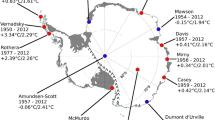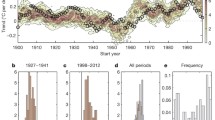Abstract
By construction, the time series for radiative forcing that are used to run the 20c3m experiments, which are implemented by climate models, impart non-stationary movements (either stochastic or deterministic) to the simulated time series for global surface temperature. Here, we determine whether stochastic or deterministic trends are present in the simulated time series for global surface temperature by examining the time series for radiative forcing. Statistical tests indicate that the forcings contain a stochastic trend against the alternative hypothesis that the series are trend stationary with a one-time structural change. This result is consistent with the economic processes that impart a stochastic trend to anthropogenic emissions and the physical processes that integrate emissions in the atmosphere. Furthermore, the stochastic trend in the aggregate measure of radiative forcing also is present in the simulated time series for global surface temperature, which is consistent with the relation between these two variables that is represented by a zero dimensional energy balance model. Finally, we propose that internal weather variability imposed on the stochastic trend in radiative forcings is responsible for statistical results, which gives the impression that global surface temperature is trend stationary with a one-time structural change. We conclude that using the ideas of stochastic trends, cointegration, and error correction can generate reliable conclusions regarding the causes of changes in global surface temperature during the instrumental temperature record.


Similar content being viewed by others
Notes
The 20c3m experiments specify the direct effects of sulfur emissions only.
For example, for CFC12 we have 0.37 = θ87, or θ = 0.371/87 ≈ 0.989.
A stochastic process is called integrated of order d, I(d), d = 0,1,2, …, if Δd X t is I(0), where I(0) is a stationary process and Δ is the difference operator, ΔX t = X t - X t-1.
References
Archer DM, Eby V, Brovkin A, Ridgwell L, Cao U, Mikolajewicz K, Caldeira K, Matsumoto G, Munhoven AM, Tokos K (2009) Atmospheric lifetime of fossil fuel carbon dioxide. Annu Rev Earth Planet Sci 37:117–134. doi:10.1146/annurev.earth.031208.100206
Banerjee A, Lumsdaine RL, Stock JH (1992) Recursive and sequential tests of the unit-root and trend-break hypotheses: theory and international evidence. J Bus Econ Stat 10(3):271–288
Bloomfield P, Nychka D (1992) Climate spectra and detecting climate change. Climate Change 21:275–287
Crowley TJ (2000) Causes of climate change over the past 1000 years. Science 289:270–277
Dickey DA, Fuller WA (1979) Distribution of the estimators for autoregressive time series with a unit root. J Am Stat Assoc 74:427–431
Dinda S, Coondoo D (2006) Income and emissions: panel data-based cointegration analysis. Ecol Econ 57(2):167–181
Estrada F, Gay C, Sanchez A (2010) Reply to “Does temperature contain a stochastic trend? Evaluating conflicting results by Kaufmann et al. Clim Chang 101(3–4):407–414. doi:10.1007//s10584-010-9928-0
Estrada F, Perron P, Gay-Garcia C, Martinez-Lopez B (2011), A time-series analysis of the 20th century climate simulations produced for the IPCC’s AR4, http://ideas.repec.org/p/bos/wpaper/wp2011-051.html
Forster P, Ramaswamy V, Artaxo P, Berntsen T, Betts R, Fahey DW, Haywood J, Lean J, Lowe DC, Myhre G, Nganga J, Prinn R, Raga G, Schulz M, Van Dorland R (2007) Changes in atmospheric constituents and in radiative forcing. In: Solomon S, Qin D, Manning M, Chen Z, Marquis M, Averyt KB, Tignor M, Miller HL (eds) Climate change 2007: The physical science basis. Contribution of working group I to the fourth assessment report of the intergovernmental panel on climate change. Cambridge University Press, Cambridge
Gay C, Estrada F, Sanchez A (2009) Global and hemispheric temperature revisited. Clim Chang 94:333–349. doi:10.1007/s10584-008-9524-8
Hansen JE, Sato M (2001) Trends of measured climate forcing agents. Proc Natl Acad Sci 98:14778–14783. doi:10.1073/pnas.261553698
Harvey LD, Kaufmann RK (2002) Simultaneously constraining climate sensitivity and aerosol radiative forcing. J Clim 15(20):2837–2861
Houghton RA (2008) Carbon flux to the atmosphere from land-use changes: 1850–2005. In TRENDS: A compendium of data on global change. Carbon Dioxide Information Analysis Center, Oak Ridge National Laboratory, U.S. Department of Energy, Oak Ridge, Tenn., U.S.A
Kaufmann RK, Kauppi H, Stock JH (2006a) Emission, concentrations, & temperature: a time series analysis. Clim Chang 77:249–278
Kaufmann RK, Kauppi H, Stock JH (2006b) The relationship between radiative forcing and temperature: what do statistical analyses of the instrumental temperature record measure? Clim Chang 77:279–289
Kaufmann RK, Kauppi H, Stock JH (2010) Does temperature contain a stochastic trend? Evaluating conflicting statistical results. Clim Chang 101:395–405
Kaufmann RK, Kauppi H, Mann ML, Stock JH (2011) Reconciling anthropogenic climate change with observed temperature 1998–2008. Proc Natl Acad Sci 108(29):11790–11793. doi:10.073/pnas.1102467108
Kaufmann RK, Stern DI (2002) Cointegration analysis of hemispheric temperature relations. J Geophys Res. 107 D2 10.1029, 2000JD000174
King RG, Plosser CI, Stock JH, Watson MW (1991) Stochastic trends and economic fluctuations. Am Econ Rev 81(4):819–840
Lean J (2004). Solar irradiance reconstruction. IGBP PAGES/World Data Center for Paleoclimatology Data Contribution Series # 2004–035. NOAA/NGDC Paleoclimatology Program, Boulder CO, USA
Lindzen RS, Giannitsis C (1998) On the climatic implications of volcanic cooling. J Geophys Res 103:5929–5941
Lumsdaine RL and Papell DH (1997) Multiple trend breaks and the unit-root hypothesis, The Review of Economics and Statistics, pp 212–218
Mann ME (2011) On long range temperature dependence in global surface temperature series. Clim Chang 107:267–276
Marland G, Boden TA, Andres RJ (2008) Global, regional, and national fossil fuel CO2 emissions. In Trends: A compendium of data on global change. Carbon Dioxide Information Analysis Center, Oak Ridge National Laboratory, U.S. Department of Energy, Oak Ridge, Tenn., U.S.A.
Meehl GA, Stocker TF, Collins WD, Friedlingstein P, Gaye AT, Gregory JM, Kitoh A, Knutti R, Murphy JM, Noda A, Raper SCB, Watterson IG, Weaver AJ, Zhao Z-C (2007) Global climate projections. In: Solomon S, Qin D, Manning M, Chen Z, Marquis M, Averyt KB, Tignor M, Miller HL (eds) Climate change 2007: The physical science basis. Contribution of working group I to the fourth assessment report of the intergovernmental panel on climate change. Cambridge University Press, Cambridge
Mills TC (2009) How robust is the long-run relationship between temperature and radiative forcing? Clim Chang 94:351–361. doi:10.1007/S10584-008-9525-7
Molina MJ, Rowland FS (1974) Stratospheric sink for chloroflouromethanes: chlorine atom-catalyzed destruction of ozone. Nature 249:810–812. doi:10.1038/249810a0
Nelson CR, Plosser CI (1982) Trends and random walks in macroeconomic time series: some evidence and implications. J Monetary Econ 10:139–162
Perron P (1997) Further evidence on breaking trend functions in macroeconomic variables. J Econometrics 80(2):355–385
Rea W, Reale M, Brown J (2011) Long memory in temperature reconstructions. Clim Chang 107:247–265. doi:10.1007/s10584-011-0068-y
Said E, Dickey DA (1984) Testing for unit roots in autoregressive moving average models of unknown order. Biometrika 71:599–607
Sato M, Hansen JE, McCormick MP, Pollack JB (1993) Stratospheric aerosol optical depths, 1850–1990. J Geophys Res 98:22987–22994
Stern DI, Kaufmann RK (1996) Estimates of global anthropogenic methane emissions 1860–1993. Chemosphere 33(1):159–176
Stern DI, Kaufmann RK (2000) Is there a global warming signal in hemispheric temperature series: a structural time series approach. Clim Chang 47:411–438
Stock JH (1994) Unit roots, structural breaks, and trends, ch. 46. In: Engle R, McFadden D (eds) Handbook of econometrics, volume IV. Elsevier, Amsterdam, pp 2740–2843
Volk CM, Elkins JW, Fahey DW, Dutton GS, Gilligan JM, Loewenstein M, Podolske JR, Chan KR, Gunson MR (1997) Evaluation of source gas lifetimes from stratospheric observations. J Geophys Res-Atmos 102(D21):25543–25564
West KD (1988) Asymptotic normality when regressors have a unit root. Econometrica 56:1397–1418
Woodward WA, Gray HL (1993) Global warming and the problem of testing for trend in time series data. J Clim 6:953–962
Woodward WA, Gray HL (1995) Selecting a model for detecting the presence of a trend. J Clim 8:1929–1937
Author information
Authors and Affiliations
Corresponding author
Rights and permissions
About this article
Cite this article
Kaufmann, R.K., Kauppi, H., Mann, M.L. et al. Does temperature contain a stochastic trend: linking statistical results to physical mechanisms. Climatic Change 118, 729–743 (2013). https://doi.org/10.1007/s10584-012-0683-2
Received:
Accepted:
Published:
Issue Date:
DOI: https://doi.org/10.1007/s10584-012-0683-2




